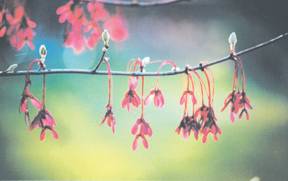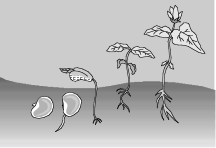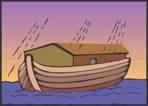

A seed covers the embryo of a young plant and its food supply. There are many designs for seeds, but they share common structures:
- an embryo (shoot/hypocotyl and root/radical)
- a food supply
- cotyledons, or the beginning of the first leaves.
- a seed coat
Seeds develop from fertilized eggs in the ovary of a flowering plant. Fruits are the mature ovaries.
A seed stores proteins, carbohydrates, oils, vitamins, and minerals for use by the young plant immediately after breaking dormancy. No wonder so much of our food is based on seeds! In fact, many think that civilization began when seeds were available to people on a regular basis. Some of the seeds used regularly by humans include:
| LEGUMES | GRAINS | SPICES | NUTS |
|---|---|---|---|
| Adzuki beans | Barley | Anise | Almonds |
| Black Beans | Corn | Caraway | Cashews | Chick Peas | Millet | Cardomon | Macademia |
| Coffee Beans | Oats | Coriander | Pecans |
| Fava beans | Rice | Cumin | Pine nuts |
| Lentils | Rye | Fennel | Pistachios |
| Lima beans | Wheat | Mustard | Walnuts |
| Mung beans | Nigella | ||
| Peanuts | Sesame | ||
| Peas | |||
| Pinto beans | |||
| Soybeans | |||
| Vanilla beans | |||

If seeds were to begin to grow while they travel on wind, water, or fur of an animal, then the plants would not grow properly. Furthermore, if the seeds were to develop immediately after arrival, then they may die because of the climate and soil conditions were not good. For example, a seed might arrive in the wrong season. Water and nutrients in frozen ground cannot be used by a growing plant. Or there may be too little rainfall for them to germinate or grow through their whole life cycle. So dormancy is a strategy for waiting until conditions are right for germination.
A seed can stay "sleeping" (dormant) for very long periods of time. Just recently, seeds over 1,000 years old were germinated in only four days once they were placed in the right growing conditions. They had "slept" in China, and when they were discovered, were sent to the Beijing Institute of Botany. Similarly, lupine seeds-perhaps as old as 10,000 years and frozen in the den of an Arctic lemming-were successfully germinated and grew to look like their contemporary counterparts.
The plant embryo of seeds is typically encased in a hard coat. This coat keeps the seed dry and free of bacteria and mold. Inside the coat, along with the embryo, is all the food the young plant will need immediately after breaking dormancy. This food includes proteins, carbohydrates, oils, vitamins, and minerals. The seed then shuts down most life functions. It loses its moisture and becomes more able to stand temperature extremes and even radiation. So the seed can go without warmth or water for an extended period of time.
The seed coat is typically so hard that you wouldn't think any signal could wake it up. Nevertheless, seeds do receive a variety of signals. For some seeds (tobacco, coleus, certain strains of lettuce), the signal is the duration or intensity of light. Phytochroms-special sensors similar to those in the human eye-make seeds sensitive to light. Seed growth is regulated by red and far-red light. For example, a bean seedling germinated in the dark will be droopy, but a blast of red light will get it growing. Some seeds, however, require dark. The poinsettia (Euphorbia pucherrima) requires at least two months of 14-hour nights to start flowering.
Many seeds will wait until they are receiving enough water to guarantee growth through the life cycle of the plant. This is especially important for plants in the desert. In the case of cacti, heavy rains wash away chemical inhibitors and the seed begins to grow. Other species require a period of drying.
For many seeds, the primary signal is a change in temperature. Every seed has a range of temperature in which it can germinate. In the early Spring at most latitudes, there are some "see-sawing" or fluctuations between warmer and cooler temperatures. Many seeds use these fluctuations as a signal to begin germination. In addition, many seeds (for example, apple seeds) must experience a cold period before they will react to temperature fluctuations. That is, for some seeds to identify spring temperature conditions, they must first experience winter temperature conditions. After these signals arrive and are registered by hormones inside the seed, germination begins.

In the moments of germination, the seed coat begins to take in water. As the seed swells, the seed coat cracks. Fat, starch, and oil in storage in the seed turn to liquid, and this stored food is turned into sugar. This sugar is what gives seeds their sweet taste. Since the young plant is growing rapidly, its cells are multiplying quickly and it needs a lot of oxygen. If the seeds are buried too deeply or in compacted soil, they may not get this necessary oxygen. The young seed leaves (called cotyledons) gradually grow out of the seed coat. When the plant begins to develop its own leaves and make its food from photosynthesis, the seed leaves fall off and the plant is on its way.

Global Lab teacher Maria Kuzniarz wrote, "I would like to tell you something about "The Black Triangle" and a gene bank. The Black Triangle is situated in three countries: Germany, Czech Republic, and Poland. It is called so, because the territory is very worn out. It doesn’t matter where you observe the trees; in Germany, Czech Republic, or Poland, they are destroyed everywhere the same. In The Black Triangle there won’t be any plants in some years, so a gene bank was started. In a gene bank, the genes of rare plants are kept and planted later in other places where they can develop. The Polish gene bank is situated in Kostrzyca. Its duty is to collect genes from many trees in Poland. The grains are frozen in small rooms, in a temperature about -20oC. The seeds are kept for 20 to 30 years, so that they can be planted in the future. In Poland, 14,000 ha of forest has to be replanted; our gene bank has to preserve 1 million genes of plants. This gene bank is called Arche Noah - Noah's Ark.